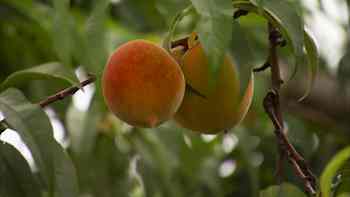By Sean Conway

Peaches on the tree
Fresh peaches are one of the true joys of summer, and in my opinion this fruit never tastes better than when it is picked ripe and juicy from the tree. If you dream of growing a peach tree or two in your own backyard, take heart: They're not difficult to cultivate, and they grow surprisingly quickly. Most varieties bear fruit at a young age, so with the proper care you can be harvesting fruit within three to four years, which is much sooner than other tree fruit such as apples or pears.
We associate peaches with the South, and indeed the southern two-thirds of the country has the best climate for growing them. But there are more than 2,000 varieties of peaches, and many are tolerant of colder climates. Selecting the right variety for your region will ensure success.
The flesh of a peach can be either yellow or white, depending on the variety, and the fruit's skin ranges in color from red to pink to yellow or a combination of the three. Most peach varieties were developed for fruit production, but there are a good number of ornamental trees grown for their flowers and foliage. Some of the latter have beautiful red leaves, while others are dwarf varieties perfect for containers on a sunny patio or deck.
If you'd like to try growing peach trees, start by selecting a site in your yard that has full sun, good air movement and well-drained soil. When selecting a tree, look for plants with healthy foliage and undamaged bark.
Pruning is very important in raising peaches. The fruit is usually produced on second-year wood, so you must always encourage new growth. Each winter, you want to prune about 30 percent of the new growth and any wood that is damaged or diseased. Most commercial peach production uses an open, vase-like form, but other pruning styles work as well. The goal of pruning is to encourage air and sun penetration, cull out damaged wood, and keeping the tree from getting so big that you can't reach the peaches. The most important thing you can do to help ensure a healthy crop is to keep the area underneath the tree free of weeds and debris.
Recently on "Cultivating Life," my friend Skip Paul from
Elberta Queen. A large, yellow-fleshed fruit great for canning or freezing.
Saturn. A unique doughnut shaped peach with white flesh and a freestone.
Early White Giant. An early, white-fleshed peach. White peaches usually are on the early side and are a little less acidic.
Pink Cascade Weeping. An ornamental weeping peach 12 to15 feet tall with pink flowers in the spring.
Bonfire. An interesting 4- to 5-foot tall ornamental peach with deep red foliage and fruit and beautiful pink and red flowers in the spring.
Sensation Miniature. Another miniature tree that is great for container growing but that also produces full-sized edible fruit.
© Sean Conway
AUTOS | HOBBIES | EDUCATION | FAMILY | FASHION | FOOD & RECIPES | HOME DECOR | RELATIONSHIPS | PARENTING | PETS | TRAVEL | WOMEN
Home & Garden - Peaches: Cultivating Backyard Mini-Orchard Not That Hard